NEET Biology Notes For Plant Kingdom Systems Of Biological Classification
The following systems of classification have been proposed from time to time. Some early attempts for the classification of plants are as follows:
- Aristotle: Grouped plants into trees, shrubs, and herbs based on their habit. He divided animals into “Enaima” and “Anaima” on the basis of the presence and absence of RBC, respectively.
- Charaka (Father of Ayurveda): Listed 200 kinds of animals and 340 kinds of plants in his book “Charak Samhita.”
Artificial System Of Classification: The artificial system of classification is based on a few morphological characters for grouping the organisms. Early systems of classifications given by Aristotle, Theophrastus, Pliny, Bauhin, John Ray, and Linnaeus are artificial systems.
- Theophrastus proposed the first system of artificial classification of plants on the basis of habit of plants into herbs, shrubs, and trees;
- Carolus Linnaeus (1707-1778) proposed the artificial system of classification based exclusively on the nature and number of stamens and carpels. It was called as a sexual system of classification.
- The classification consisted of 24 classes, in which 23 classes were of flowering plants (Phanerogamia) and the 24th class had flowerless plants (Cryptogamia).
The details of his classification were published in Genera Plan/arum (1737). Total 24 classes given by Linnaeus were: Monandria, Diandria, Triandria, Tetrandria, Pentandria, Hexandria, Heptandria, Octandria, Enneandria, Decandria, Dodecandria, Icosandria, Polyandria, Didynamia, Tetradynamia, Monadelphia, Diadelphia, Polyadelohia, Syngenesia, Gynandria, Mcnoecia, Dioecia, Polygamia, and Cryptogamia.
Artificial System Of Classification Drawbacks
- Because this system was based on few characters, hence diverse animals and plants were placed into a limited number of groups.
- No natural or phylogenetic relationships were considered.
Natural System Of Classification: The natural system of classification is known as the horizontal system of classification or 2D system. Organisms in this system are classified on the basis of natural affinities.
- This system uses as many taxonomic characters as possible to group organisms. This classification is mainly based on form relationships realizing all information available at the time of collection of plants.
” plant kingdom”
- The classification systems proposed by John Ray, de Jus- siaeu, de Candolle, Bentham, and Hooker were natural.
- George Bentham and J.D. Hooker (1833-1862) gave the most important system of classification of angiosperms and published it in three volumes of “Genera Plantarum.’’
- They described 202 families. In this system, the description of plants was based on their detailed studies and dissections. It is widely acceptable and all British commonwealth countries including India widely follow this system for practical purposes, hence, it is called practical classification.
Read and Learn More NEET Biology Notes
Bentham And Hooker’s Classification: Bentham and Hooker divided plant kingdoms into two subking-doms—Cryptogamia (non-seeded plants) and Phanerogamia (seeded plants). Phanerogamia was further divided into three classes—dicotyledons, gymnosperms, and monocotyledons.
An outline of the classification of Phanerogamia is given below.
Class 1: Dicotyledonae: Pentamerous flower, reticulate venation in leaves, two cotyledons in seed, vascular bundles open (with cambium), secondary growth present, wood formation occurs. It is divided into three sub-classes
- Sub-class 1 Polypetalae: Petals free and separate. It has three series.
- Series 1 Thalamiflorae: Flower hypogynous, stamens and pistils many (indefinite), petals free, distinct sepals are free from ovary. It has six orders.
- Series 2 Disciflorae: Flower hypogynous, calyx consists of free or united sepals, petals free, a prominent cushion-shaped disc is present below the ovary. It has four orders.
- Series 3 Calyciflorae: Flower perigynous or epigy- nous. Calyx contains united sepals (rarely free); ovary inferior. It has five orders.
- Sub-class 2 Gamopetalae: Petals united or fused. It is divided into three series.
- Series 1 Inferae: Flower epigynous, ovary inferior; stamens as many as corolla lobes or fewer. It has three orders.
- Series 2 Heteromerae: Ovary usually superior; carpels more than two. it has three orders.
- Series 3 Bicarpellatae: Ovary usually superior, two carpels (rarely one or three). It has four orders.
- Sub-class 3 Monochlamydeae: Flower incomplete; no distinction between calyx and corolla present which is usually sepaloid and may be absent. It is divided into eight series.
- Series 1 Curvembryeae: Embryo curved; generally one ovule in the ovary which is one in each locule.
- Series 2 Multiovulatae: Aquaticae-Plants are aquatic, submerged herbs, syncarpous ovary.
- Series 3 Multiovulatae Terrestres: Plants are terrestrial, syncarpous ovary.
- Series 4 Microembryae: Very minute or small embryo.
- Series 5 Daphnales: Ovary with one carpel and one ovule.
- Series 6 Achlamydosporeae: Ovary unilocular with one to three ovules. Ovary inferior.
- Series 7 Uniscxulaes: Flower unisexual.
- Series 8 Ordines Anomali: Families having plants with anomalous (abnormal) characters.
Class 2 Gymnospermae: Sex organs on cones, perianth absent, ovule naked (not found inside ovary), seeds are also naked, haploid endosperm. It has three families: Gnctaceae, Coni ferae, and Cycadaccae.
Class 3 Monocotyledonae: Parallel venation in leaves, embryo with one cotyledon, flower usually trimerous, wood absent, and no secondary growth. It is divided into seven series.
- Series 1 Microspcrmae: Ovary inferior, seeds minute.
- Series 2 Epigynae: Ovary inferior, seeds larger.
- Series 3 Coronarieae: Ovary superior, perianth colored.
- Series 4 Calycineae: Ovary superior, perianth green.
- Series 5 Nudiflorae: Perianth absent, ovary superior.
- Series 6 Apocarpae: Carpels free (apocarpous).
- Series 7 Glumacae: Flowers arranged in spikelets with bracts, Perianth reduced, bracts large and scaly.
In this classification, class is like division, series is like class, cohort is like order, and order is like family.
Merits Of Bentham And Hooker System Of Classification
- It is useful for practical value. In India, it is the most used system.
- Ranales have been given a primitive position and monocots are considered as advanced.
Demerits Of Bentham And Hooker System Of Classification
- Gymnosperms were placed between dicots and mono-cots.
- Many important floral characters have been neglected.
- It is not a phylogenetic system. The idea was to believe on the fixity of species.
- Some closely related families were separated and placed under different cohorts, and unrelated families have been put nearer.
- Advanced families such as Orchidaceae have been considered as primitive.
Phylogenetic System Of Classification: The phylogenetic system of classification is also known as the vertical system or 3D system of classification. The term phylogeny was given by Lamarck. Phylogeny is the evolutionary history of an organism.
- According to this system of classification, plants are classified according to their evolutionary and genetic affinities. In this system organisms belonging to the same taxa are believed to have a common ancestor and may be represented in the form of a family tree called a cladogram.
- A.W. Eichler modified Bentham and Hooker’s system by placing gymnosperms in the beginning. He is also known as the pioneer in the phylogenetic system of classification.
Adolph Engler and Karl A.E. Prantl, two German botanists, adopted their system in “Die Naturalichen Pilanzen Familien” (1887-1915). It was a German work that was later translated in English. The work had 23 volumes.
An Outline Of Engler And Prantl System Of Classification
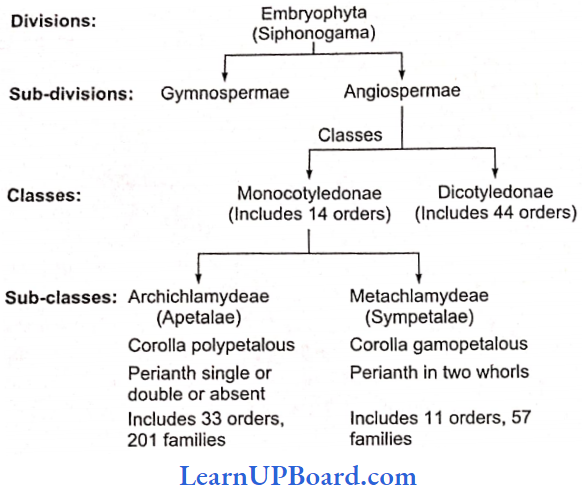
Phylogenetic Merits Of This System: In this system, families are arranged according to the increasing complexity of flowers.
Phylogenetic Demerits Of This System
- Monocots were considered primitive to dicots.
- According to this system, primitive forms having naked flowers were kept in the beginning. The more advanced families have distinct perianth, while the highly evolved families have fused perianth.
John Hutchinson presented the phylogenetic classification in his famous book Families of Flowering Plants in 1959. In Hutchinson’s classification,
- Trees and shrubs are considered to be more primitive than herbs.
- Dicots have been considered more primitive than monocots.
- Polypetalous, actinomorphic, and solitary flowers are considered more primitive than gamopetalous, zygomorphic, and inflorescence, respectively.
An outline of Hutchinson’s classification is given. The divisions include orders which again include families. Division does not include classes. Takhtajan stated that “taxonomy without phylogeny is like bone without flesh.”
An Outline Of Hutchinson’s System Of Classification
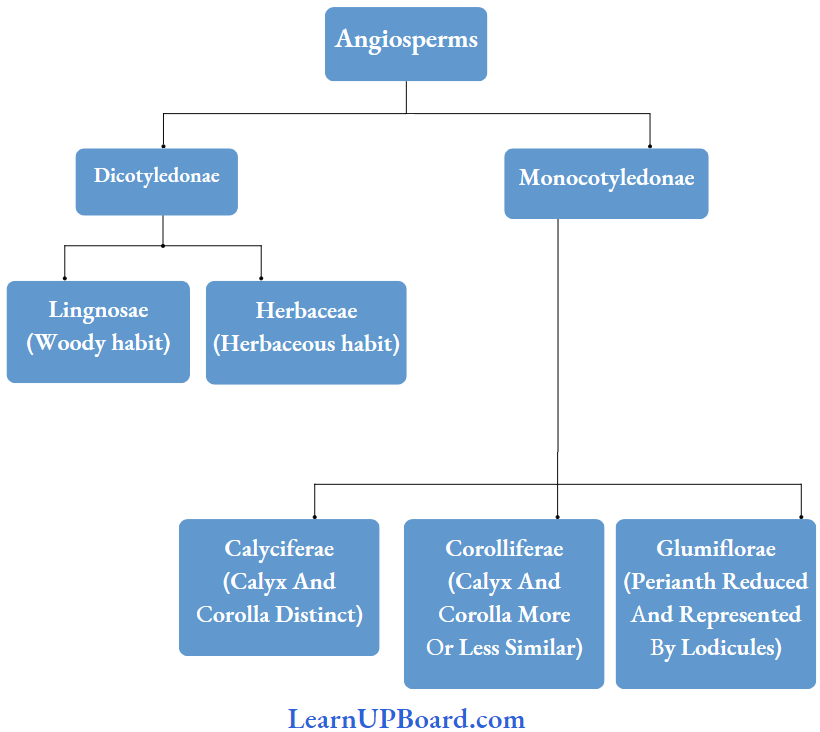
NEET Biology Notes For Plant Kingdom Branches Of Taxonomy
Classical Taxonomy: It deals with employing all available information to classify organisms on the basis of their origin, evolution, affinities, and variations.
Numerical Taxonomy/Phenetics/Taximetrics/Adansonian Taxonomy
- It uses statistical methods for evaluating similarities and differences between species. All selected characters are given equal importance. The comparison has been made easier with the availability of sophisticated calculating machines and computers.
- Dendrogram is the family tree of organisms on the basis of numerical taxonomy.
Biosystematics: It deals with the variations within a species and its general evolution.
Cytotaxonomy/karyotaxonomy: Based on the cytological information on cell, chromosome number, and their structure and behavior during meiosis.
Chemotaxonomy: Based on chemical constituents of plants, for example, betacyanin pigment in beetroots, raphides, and cystolith, sequencing DNA, and the chemical nature of proteins.
plant kingdom chart
Turril Divided Taxonomy Into Three Types:
- α-taxonomy: It is based on gross morphological features including compilation of monographs and flora.
- β-taxonomy: It is based on morphology and evidence from genetics, cytology, anatomy, physiology, etc.
- Ω-taxonomy: It includes all microscopic and biochemical evidence.
NEET Biology Notes For Plant Kingdom Classification Of Plant Kingdom
There are five major groups of Plant Kingdoms or Kingdom Plantae. These are:
- Thallophyta
- Bryophyta
- Pteridophyta
- Gymnosperms
- Angiosperms
NEET Biology Notes For Plant Kingdom Thallophyta (Algae)
General Characters Of Algae Are As Follows:
- Eukaryotic, autotrophic, chlorophyllous, cryptogamic, thallophytes.
- Aquatic, either freshwater or marine.
- They are found in many forms: unicellular (for example, Chlamydomonas), colonial (for example, Volvox), palmelloid (for example, Tetraspora), dendroid (for example, Prasinocladus), filamentous unbranched (for example, Spirogyra), or branched (for example, Cladophora), heterotrichous (for example, Fritschiella, Coleochciete, Stigeoclonium), siphonaceous (for example, Vaucheria), parenchymatous (for example, Ulva).
- Reserve food is mainly starch.
- Vegetative Reproduction: It takes place by fragmentation.
- Asexual Reproduction: Zoospores, aplanospores, hypnospores, akinetes, palmella stage, autospores, etc.
- Sexual Reproduction
- Sex organs are unicellular or multicellular with all fertile and non-jacketed.
- The embryonic stage is absent.
- Sexual Reproduction Three Types:
- Isogamous,
- Anisogamous, and
- Oogamous.
- Sporic or gametic or zygotic meiosis occurs in life cycle.
R.E. Fritsch classified algae into 11 classes in his book Structure and Reproduction of the Algae mainly on the basis of pigmentation, reserve food, flagellation, thallus structure, modes of reproduction, and life cycles.
Whittaker included only Chlorophyceae (green algae), Phaeophyceae (brown algae), and Rhodophyceae (red algae) in algae under Kingdom Plantae.
Green Algae (Chlorophyceae) General Characters
- Mostly freshwater (Spirogyra. Ulothrix, Chara, Chla- mydomonas, Volvox, etc.) and some arc marine (Ac- etabularia, Ulva, etc.).
- Photosynthetic pigments are chlorophyll-a, chloro-phyll-b, and carotenoids.
- Isokont flagellation.
- Thylakoids are in the group of 2-20 per lamella.
- Pyrenoids present.
- Three types of life cycles occur in green algae:
- Haplontic life-cycle, for example, Ulothrix, Spirogyra. Chlamydomonas (zygotic meiosis occurs).
- Diplontic life-cycle, for example, Caulerpa (gametic meiosis).
- Diplohaplontic life cycle, for example, Ulva, Cladophora. In this type of lifecycle, haploid and diploid phases are well-developed and multicellular. The isomorphic alternation of generation is found.
Chlamydomonas: It is unicellular, motile, pyriform, or pear-shaped. Cell wall is made up of hydroxyproline (glycoprotein). Flagella are isokont, whiplash type. Presence of neuromotor apparatus (basal granules + paradesmos + rhinoplasty + centrosome).
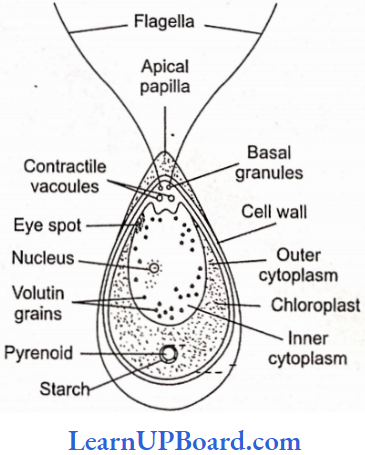
Presence of single cup-shaped chloroplast with a single pyrenoid. Two contractile vacuoles, single eye spot or stigma as photoreceptor organ is present.
Chlamydomonas Reproduction
- Asexual Reproduction: It is of the following types:
- By Zoospores: Under favorable conditions.
- Palmella Stage: It is formed in response to desiccation conditions and toxic salts. Palmella spores are green, non-motile, and are capable of growth and division.
- By Aplanospore (Thin-Walled Spore) Or Hypno- Spores (Thick-Walled Spore): These are formed under drought conditions. Aplanospore formation occurs in C. caudata.
- Sexual Reproduction: It is of the following types
- Isogamy: Fusion of similar gametes, for example, C. debaryana (homothallic) or C. reinhardii (heterothallic).
- Anisogamy: Fusion between a motile, smaller male gamete and a motile larger morphologically dissimilar female gamete, for example, C. braunii.
- Hologamy: Fusion of young cells, for example, C. media.
- Oogamy: Fusion between a motile male gamete and a non-motile female gamete, for example, C. coccifera.
Spirogyra: It is commonly known as summer alga or “hair of princess” “pond silk” “water silk” or “pond scum” (due to mucilage covering found in stagnant water). The cell wall is two-layered; the outer wall of pectose (water soluble which forms mucilage) and the inner wall of cellulose.
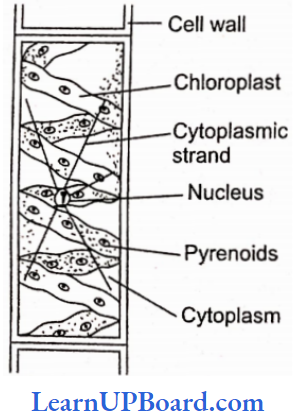
- The primordial utricle is present as a thin peripheral cytoplasm due to a large central vacuole. Presence of 1-16 ribbon-shaped, spiral chloroplast. Coiling is sinistral or left-handed. Many pyrenoids are present.
- Spirogyra adnata and S.jogensis remain attached to the substratum by basal cells called holdfast or hapteron.
“plant kingdom classification chart “
Spirogyra Spirogyra Reproduction
- Vegetative Reproduction: By fragmentation
- Asexual Reproduction: It is generally absent except in the following:
- By Parthenospores Or Azygospores: Example, Spirogyra various. If placed in a sugar solution, it develops parthenospores.
- By Akinetes: Example, S. Farlow
- By Aplanospores.
- Sexual Reproduction: It occurs by conjugation. It is physiologically anisogamous type. Types of conjugation are:
- Scalariform Conjugation: The most common type; occurs in heterothallic and homothallic species. A minimum of two filaments are involved, for example, S. tmvensis.
- Lateral Conjugation: Two adjacent cells of the same filament function as gametangia. It is a primitive type and uncommon.
- Direct Lateral Conjugation: Example, S.jogensis
- Indirect Lateral Conjugation: Example, S. affinis.
Economic Importance Of Green Algae
- Codium and Ulva (Sea lettuce) is used as salad or vegetables in European countries after drying and salting.
- Chlorella pyrenoidosa (called space alga) is used by exobiologists for food, oxygen, and disposal of CCE and organic waste in prolonged space flight.
- Cephaleuros virescence is a parasitic green alga that causes red rust of tea disease.
Brown Algae (Phaeophyceae) General characters
- The members of this group are called brown algae due to their characteristic brown color derived by the presence of an extra brown pigment, fucoxanthin.
- The brown algae are almost exclusively marine plants found primarily in the coastal zones. These occur mainly in the cooler seas. However, the Sargassum is a well-known warm-water form that occurs in the North Atlantic Ocean region and forms the Sargassum Sea.
- No unicellular brown algae is known. Except for a few members, most brown algae are macroscopic. Some of these are of massive sizes such as Laminaria (2 – 9 m); Nereocystis (45 m); Macrocystis (60-90 m). Because of their bulky appearance, these are called giant kelps. The body of a typical brown alga (for example, Laminaria) is differentiated into
- A holdfast,
- A stipe, and
- Lamina.
- In some large brown algae, certain cells are modified into long filaments called trumpet hyphae. These carry food from the lamina to the holdfast.
- The cell walls of brown algae are generally composed of two layers: an inner cellulosic layer and an outer mucilaginous layer. The cellulosic walls are covered by a colloidal covering called phycocoUoids.
- Alginic acid is an important component of hydrocolloids and is commercially obtained from kelps. It has hemostatic properties and has been used in emergency transfusions in the treatment of shock. Sodium alginate is used as a stabilizer in food industries; and calcium alginate in plastics. Forms of alginic acid are used in textile, rubber, and paint industries. It is also used for making smooth ice creams.
- The cells of brown algae contain in addition to other normal structures small colorless vesicles called fu- cosan vesicles. The function of these vesicles is not known.
- The cells contain pigment fucoxanthin in addition to chlorophyll-a and c. Fucoxanthin dominates over the green color of the chlorophyll, imparting a brown color to the algae.
- The reserve food material is in the form of laminarin starch and mannitol.
Brown Algae (Phaeophyceae) Asexual Reproduction: Asexual reproduction by fragmentation is quite common. Detached vegetative parts of brown algae have great potential to develop into new individuals. Asexual reproduction also occurs by motile or non-motile spores formed inside large-sized cells called sporangia which may be unicellular (unilocular) or multicellular (multicellular.)
Brown Algae (Phaeophyceae) Sexual Reproduction: Sexual reproduction takes place by the formation of flagellate gametes that are generally formed inside gametangia. In some cases, the female gamete is non-motile. The gametes may be isogametes (both male and female gametes exactly similar), isogametes (both similar, but female, gamete larger than male gamete), and oogamous (female larger non-motile; male motile smaller).
Economic Importance Of Brown Algae
- Fucus and Laminaria are rich sources of iodine.
- Laminaria yields a food product rich in carbohydrates called kombu and similarly, A/aria yields a product called sarumen in Japan.
- Durvillea has antiworm properties.
Red Algae (Rhodophyceae) General Characters
- They are called so because of their reddish color due to the presence of special pigments: r-phycocyanin and r-phycoerythrin. They are mostly marine.
- In deeper oceans, these acquire deeper color. Actually, only the blue-green light reaches the deep water. The pigment r-phycoerythrin in red algae does the job of capturing light of available wavelengths for red algae.
- Red algae show a variety of forms. Their thallus ranges from microscopic, unicellular to neatly hull a meter in length. These may be unicellular, filamentous, ribbons-shaped, or leaf-like. Some of these secrete calcium carbonate over their walls and form coral-line structures. In certain coral reefs, red algae such as Corallina are the main producers.
- Some red algae are parasitic. For example, llarveyella is parasitic on other red algae. The parasitic forms are colorless.
- The cell wall contains cellulose and pectic materials together with certain polysaccharides called hydrocolloids, some of which contain sulfur, for example, agar is used widely in preparing solid food media for the growth of bacteria or fungi in the laboratory. Agar has no food value for bacteria or fungi. It is also used by human beings as a thickening and binding agent in various food products. Agar agar is obtained commercially from the red algae Geliclum and Gracilaria.
- The cell walls of red algae also contain another bio-chemical carrageenin which is also widely used as a thickening and binding agent in food products, especially in puddings.
- The cells may be uninucleated or multinucleated with one or more plastids that may be with or without pyrenoids. The food reserves lie in the form of floridean starch and a soluble sugar fluoridoside (a galactoside of glycerol).
- Asexual reproduction takes place with the help of non-motile spores. Reproduction by fragmentation is not common, though some red algae are able to regenerate the full plant from a severed holdfast.
- Sexual reproduction is highly advanced and oogamous. Flagellated gametes are absent in red algae. The male gametes called spermatia develop in specialized structures called spermatangia while the female cells are called carpogonia. The carpogonium is a flask-shaped body having a neck-like trichogyne.
- Alternation of haploid and diploid multicellular generations occurs in many algae.
NEET Biology Notes For Plant Kingdom Thallophyta (Algae) Points To Remember
Red snow is caused by hypnospores of Chlamydomonas nivalis. They contain a carotenoid pigment called hematochrome
Bald spot: Receptive, colorless spot of oogonium through which male gamete enters. Chlamydomonas prefers habitats rich in ammonium salts.
NEET Biology Notes For Plant Kingdom Bryophyta
Bryophyta General Characters
- They are found in moist and shady places, i.e., sporophytes. They are often found to grow during the rainy season forming green carpets or mats on damp soil, rocks, walls, tree trunks, etc.
- Bryophyta Exceptions
- Aquatic Forms
- Ricciafluitans
- Ricciocarpus nutans
- Riella; Funtinalis
- Saprophytic Forms:
- Cryptothallus mirabilis
- Buxbaumia aphylla
- Epiphytic Form:
- Frullania
- Aquatic Forms
- Bryophyta Exceptions
- The dominant phase or plant body is a free-living gametophyte.
- Vascular tissues are absent.
- Roots are absent, instead, rhizoids occur. The latter may be unicellular or multicellular.
- Vegetative reproduction is quite common through fragmentation, tubers, gemmae, buds, adventitious branches, etc. Mitospores are not formed.
- Sex organs are multicellular and jacketed. They are of two types, male antheridium and female archegonium.
- An external layer of water is essential for the swimming of male gametes and to reach the archegonia.
- Fertilization produces an embryo inside the archegonium. The embryo grows into a sporophyte.
- Sporophytes is parasitic over gametophyte.
- The sporophyte of bryophytes is also called sporogonium. It produces haploid spores inside its capsule part while attached to the gametophyte.
- On germination, each spore produces a gametophyte either directly or through a juvenile filamentous stage called protonema.
- Bryophytes show heteromorphic or heterologous alter-nation of generations in the life cycle.
Classification Of Bryophyta: Shows the classification of Bryophyta.
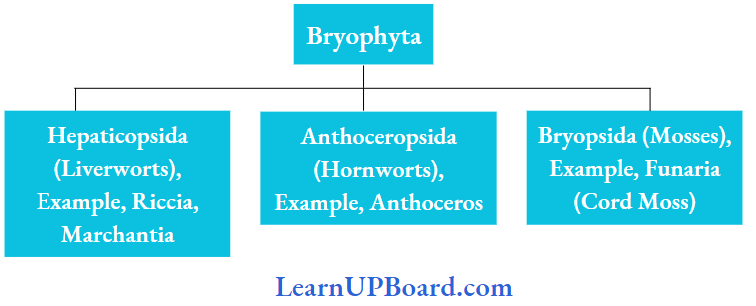
Life Cycle Of Funaria hygrometrica
- Funaria is a radially symmetric plant that is differentiated into stem or central axis, leaves or phyllodes, and rhizoids. The rhizoids are multicellular, branched with oblique septa. It is monoecious and autogenous (i.e., both sex organs on the same plant but on different branches).
“classification of plants kingdom “
- Antheredia are borne in groups at the tip of the main axis and surrounded by perigonial leaves. Archegonial clusters on lateral branch tip and surrounded by perichaetial leaves. Thus, both male and female gametangia are acrocarpous. Male gametes or sperms are elongated biflagellates with curved bodies. Number of neck canal cells (NCC) in archegonium is 6-10.
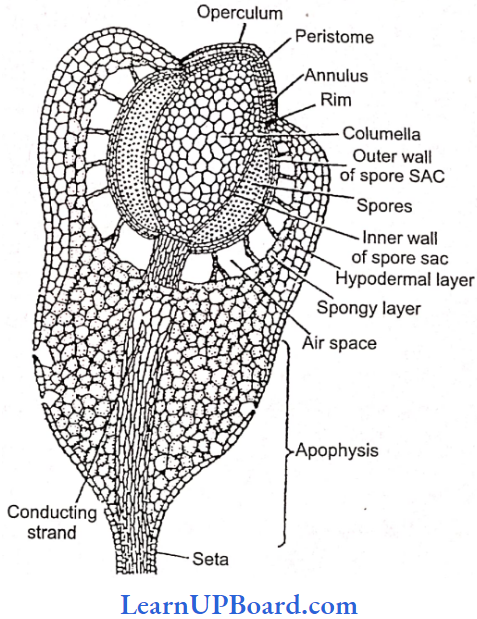
Diploid oospore develops into sporophyte. Mature sporogo- nium is differentiated into foot, seta, and capsule. The foot is embedded in a gametophytic plant body meant for the absorption of water, mineral salts, and fixation. Seta is a narrow stalk that lifts the capsule in the air. The capsule is differentiated into three parts: apophysis, theca, and operculum.
Apophysis contains assimilatory tissue; and stomata with a single annular guard cell. Theca contains central sterile columella, a spore sac, air cavity, and assimilatory tissue. The operculum is separated from theca by a one-celled elongated diaphragm. Above the hill lies a few layers of thin-walled cells fonning annulus.
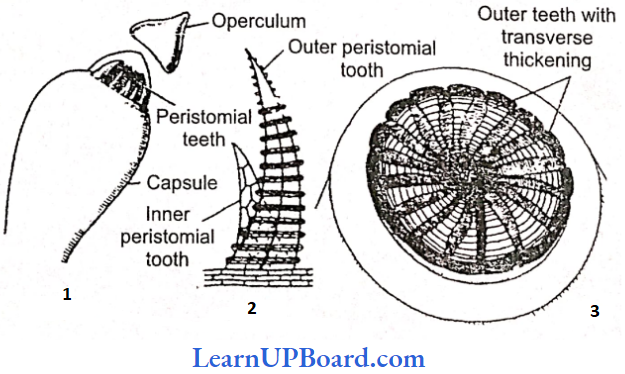
Peristomial teeth are 32, acellular, arranged in two rings of 16 each. The outer peristomial teeth are exostome, and bear transverse thickening of cellulose, showing hygroscopic movement. Endostome or inner peristome teeth are without cellulose thickening, act as sieves, and check the sudden dispersal of spores.
NEET Biology Notes For Plant Kingdom Bryophyta Points To Remember
The smallest bryophyte is Zoopsts.
- The largest bryophyte is Dawsonia,
- The largest archegonium in the plant kingdom is of Funaria.
- Gemmae in Funaria arc formed at the tips of chloroma branches of protonema.
- Apospory is present in Funaria. It introduces polyploidy in the race.
- Sphagnum upon death gets compressed and fossilized over thousands of years to produce a dark spongy mass called peat which is dried, cut, and used as fuel as well as good manure.
- Dry Sphagnum can absorb 18-26 times its weight of water. In older times, Sphagnum moss was used in the place of absorbent cotton.
- Polytrichum commune was employed in removing kid¬ney stones.
- The oldest bryophyte fossils are 350 million years old, for example, Hepaticites, and Ricciopsis.
- Bryophytes are adapted to land by having a waxy coating on aerial parts.
- Bryophytes become seldom taller than 20 cm due to the lack of vascular tissue.
- Elaters in Marchanlia are diploid and have spiral thickenings. They help in spore dispersal.
- The air sacs in the capsule ofmoss act as shock absorbers.
- Bryopsida: Common Names
- Polytrichum: Hair cap moss
- Sphagnum: Peat/bog moss
- Andrea: Granite moss
- Grimmia: Black moss
- Tortula: Twisted moss
- Ptilium: Feather moss
- Rhodobiyum: Rose moss
- Merceya: Copper moss
- Climacium: Tree moss
- Dicranum: Wind-blown moss
NEET Biology Notes For Plant Kingdom Pteridophyta
Pteridophyta General characters
- The term pteridophyta was given by E. Haeckel for plants with feather-like fronds.
- The first group of tracheophytes. The plant body is sporophytic.
- Vascular tissues are present. They are of two types, xylem, and phloem. In the xylem, true vessels are absent. In phloem, companion cells are absent and sieve cells are present.
- Meiospores are formed inside sporangia. Sporangia are associated with leaves called sporophylls.
- Sporangium development is of two types:
- Leptosporangiate: When sporangium develops from the single superficial cell, for example, Pteris, Diyopteris, and A-chan turn.
- Eusporangiate: When sporangium develops from a group of cells, for example, Selaginella, or Equisetum.
- Sex organs are multicellular and jacketed; antheridia are reduced. Archegonia are partially embedded.
- Sperms arc flagellate. They require an external supply of water for swimming to reach Archegonia.
- The embryo stage is present.
- Embryogeny is of two types:
- Exoscopic Embryogeny: Axis of the embryo is directed towards the archegonial neck, for example, the Equisetum.
- Endoscopic: Axis of the embryo is directed inward towards the center, for example, Selaginella.
- Development Of Embryo
- Holoblastic: When the entire zygote is involved in embryonic development, for example, ferns.
- Meroblastic: When a part of the zygote is involved in embryonic development, for example, Selaginella.
- Heteromorphic or heterologous alternation of generations is present in the life cycle.
Steler System: The Steler theory was proposed by Van Teigham and Douliot.
Types Of Steler
1. Protostele: Simplest type, without pith
Haplostele: Example, Rhynia.
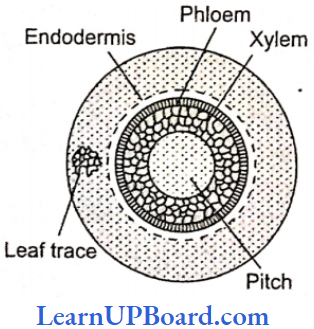
Actinostele: Example, Lycopodium serratum.
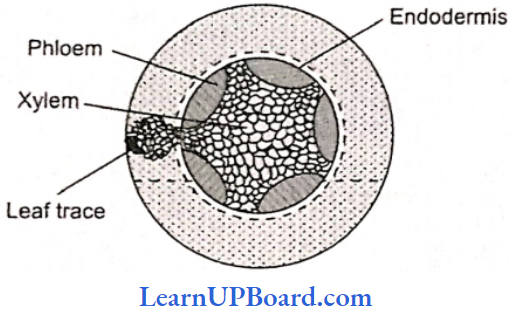
Plectostele: Example, Lycopodium clavatum.
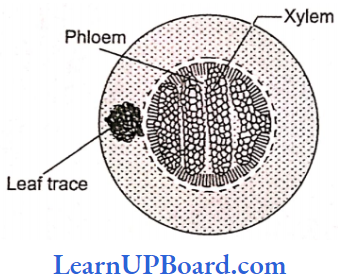
Mixed Protostele: Example, Lycopodium cemum.
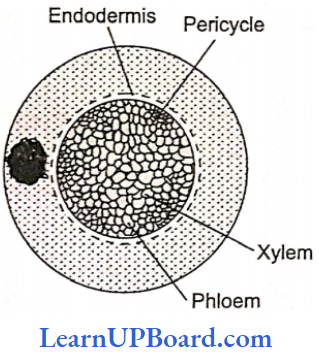
2. Siphonostele: With pith.
Ectophloic Siphonostele: Example, Osmunda, Botrychium.
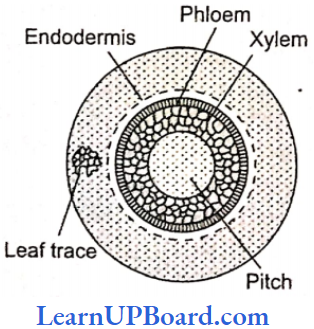
Amphiphloic Siphonostele: Marxilea.
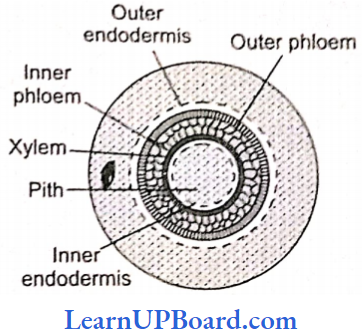
Solenostele: Stele with one or few leaf gaps. For example, Adiantum caudatum.

Dictyostele: Stele with a large number of overlapping leaf gaps, for example, Dryopteris, Pteris, etc.
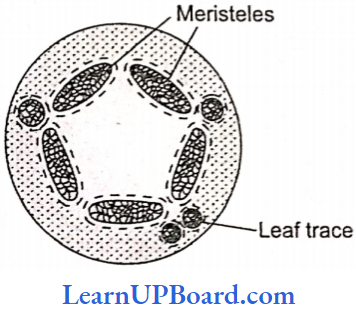
Eustele: Conjoint, collateral open vascular bundles, for example, dicot stem, gymnosperm.
Atactostele: Closed vascular bundles scattered in the ground tissue, for example, monocot stem.
Life Cycle Of Selaginella Salient Features
- The plant body is an evergreen sporophyte. It is differentiated into stems, leaves, and roots. The roots often develop at the tips of special structures called rhinophores.
- The plant body can multiply vegetatively by fragmentation, bulbils, and tubers. Bulbils and tubers help in perennation as well.
- Sporangia develop in the axil of fertile leaves or sporophylls at the tips of small branches called spikes. There are two types of sporangia, microsporangia and mega¬sporangia.
- Each microsporangium produces a large number of small haploid microspores. A megasporangium develops only four haploid megaspores. Growth of the gametophytes is precocious.
- Microspore produces an endosporic 13-celled male gametophyte. The latter has one urothelial cell eight jacket cells and four androgenic cells. The androgenic cells form 128-256 astrocytes or sperm mother cells. A sperm mother cell gives rise to a biflagellate sperm.
- Megaspore produces a partially exospheric female gametophyte. The female gametophyte contains an exposed generative apical cushion and a storage tissue. The two are separated by a diaphragm. The apical cushion produces archegonia and rhizoids. Each archegonium has a single female gamete or oosphere. Fertilization requires the help of external water for the swimming of sperm. It produces diploid oospores.
- The oospore divides to form a suspensor and embryo. The development of the embryo is meroblastic. A suspensor helps in pushing the embryo into food-laden storage tissue. The embryo has a foot for absorbing nourishment, a shoot tip, and a root tip. The latter two elongate and produce an independent sporophytic plant body.
- Selaginella shows two distinct generations, sporophyte and gametophyte, one producing the other. They are morphologically different. The phenomenon is called hetero-morphic or heterologous alternation of generations.
- Under dry conditions, the xerophytic species of Selaginella roll on into brown balls. The phenomenon is called cespitose habit. In this state, it may be uprooted. The brown balls become green and unroll again under moist conditions. Because of this characteristic, these plants are known as resurrection plants, for example, S. lepidophylia, and S. bryopteris.
- The plant body of Selaginella chrysocaulos and S. selaginoides is erect. Its leaves are anisophyllous and arranged in two rows. In S. kraussiana, the plant body is prostrate. Its leaves are anisophyllous or dimorphic and arranged in four rows.
- The stem in Selaginella is distelic. Rarely, the stem is monostelic.
- Bower and Goebel named the rhizosphere of Selaginella as an organ suigeneris, i.e., the organ having the characteristics of both, i.e., stem as well as root, but independent in origin.
- The mucilage oozing out of the neck of archegonium in Selaginella and fern contains malic acid. The neck of archegonium in Selaginella and fern contains only one neck canal cell.
- Selaginella rupcstris shows a near approach to seed habit.
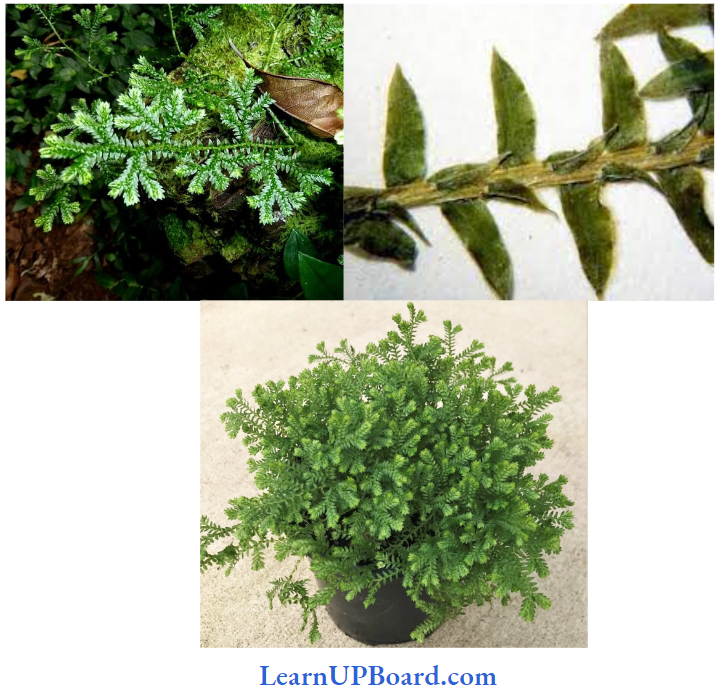
Ferns General Characters
- Plant body is a sporophyte. It is differentiated into true stems, leaves, and roots.
- The stem is an underground rhizome in most of the ferns. Some are called tree ferns, for example, Cyathea, and Celotia.
- Leaves or their leaflets show furcate venation in which veins branch dichotomously without forming interconnections.
- The younger parts of the stem, young leaves, petiole, and rachis of mature leaves possess hairs or scales called ramenta. Ramcnta protects them from mechanical injury and desiccation.
- Young leaves show circinate ptyxis that is they are coiled in the form of a watch spring. This coiling protects the growing point which comes to lie in the center.
- Sporangia occur on the leaves in clusters called sori (singular-sows). The fertile leaves are known as sporophylls. A sorus is covered by a flap-like outgrowth from its surface (true indusium, for example, Dryopteris) or turned margin of the sporophyll (false indusium, for example, Adiantum).
Life Cycle Of Dryopteris
- Dryopteris Salient Features: It is found in moist shady places in tropical, subtropical areas. The plant body is perennial, independently living evergreen sporophyte having vascular tissues. It is differentiated into stems, leaves, and roots. Roots are adventitious.
- Stem is an underground, dark brown rhizome. The large aerial leaves or fronds are incompletely bipinnate compound leaves. The young leaves show circinate ptyxis. Persistent leaf bases of the dead leaves arc found in the older parts of the rhizome.
- In Dryopteris, a leaflet receives a single midrib which gives rise to lateral veins showing dichotomous divisions. The young leaves, young parts of the rhizome, petiole, and rachis of mature leaves are covered over by brown to black scales called paleae or ramenta.
- Dryopteris Reproduction: The fern multiplies vegetatively by fragmentation of rhizome and development of adventitious buds. In Dryopteris, the adventitious bud present at the leaf base separates and grows into a new plant. In Adianlum caudatum and a few other species, adventitious buds develop at leaf tips.
When such leaf tips happen to touch the soil, they form new plants the process helps in spreading the fern over a large area. Because of this reason, Adianlum caudatum is also called walking fern and maidenhair fern.
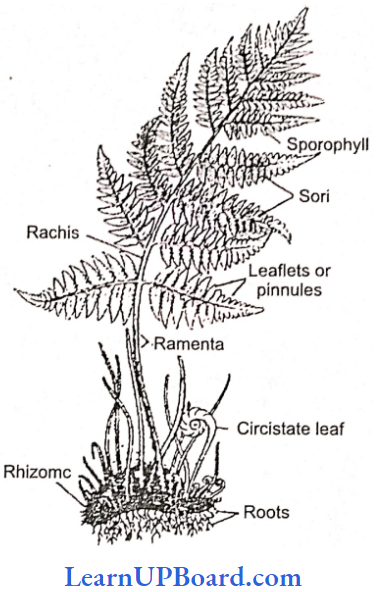
The leaflets of a mature leaf bear sporangia in clusters called sori. The leaflets and leaves having sori or sporangia are called sporophylls. In Adianlum, the sori are borne submarginally at the distal end on the undersurface of the leaflets. The margin of the leaflet is reflexed to cover the sprus. The reflexed margin is known as false indusium.
“plant kingdom classification pdf “
In Diyopteris, the sori develop in two rows, one on either side of the midrib. Each row contains 4-6 sori except in smaller leaflets which may have 1-2 sori or can be sterile. Each sorus is covered by a membraneous sheath of its own. This covering is carted true indusium. The covered sori of Dryopteris are kidney-shaped in outline. This has given the name of the male shield fern to Dryopteris.
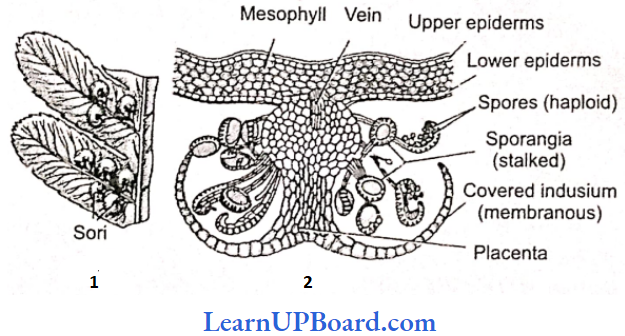
A sorus consists of a parenchymatous cushion or placenta. The placenta bears a number of stalked biconvex sporangia. In each sporangium, there is a single-layered jacket that encloses 12-16 diploid spore mother cells. A marginal row of jacket cells are differentially thickened to form an annulus.
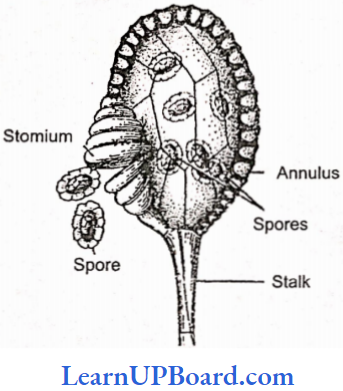
The remaining marginal cells constitute stomium. The diploid spore mother cells divide meiotically to form haploid spores. With the maturity of spores, the indusium shrivels. The exposed sporangia dehisce in the region of the stomium is due to differential contraction of the annulus. The spores are dispersed by air currents.
After failing on suitable soil, each spore germinates and forms a thalloid gametophyte called prothallus. Prothallus is cordate, green, and flat in structure. Prothallus bears antheridia and archegonia at the ventral surface.
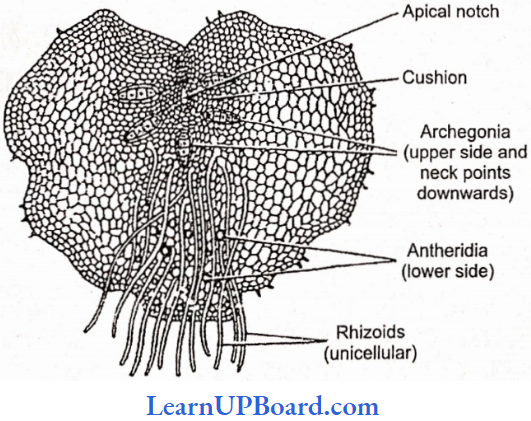
Antheridium has a three-celled jacket and about 32 sperm mother cells. The sperms are multiflagellate (multiciliate) and spirally twisted. Flask-shaped archegonium has a single binucleate neck canal cell, a single venter canal cell, and an oosphere. Sperms are attracted to the opened archegonia by malic acid present in their mucilage. Diploid oospore gives rise to an embryo that grows in size to form the fern plant.
NEET Biology Notes For Plant Kingdom Pteridophyta Points To Remember
- Common names
- Spike moss (Selaginella)
- Bird’s nest moss (Selaginella rupesiris)
- Club moss (Lycopodium)
- Smallest ptcridophyte – Azolla (an aquatic fern)
- Largest ptcridophyte = Cyathea (tree term)
- Apogamy: It is the development of haploid sporophytes from gametophytes without fertilization. It was reported by Farlow in Pier is erotica.
- Apospory: It is the development of diploid gametophyte from sporophyte without meiosis. It was reported by Druery in Athyrium. Due to apospory, polyploidy is common in ferns.
- Psilofales such as Rliyniu were the first trachcophytes.
- Azolla is a water fern used as a biofertilizer.
NEET Biology Notes For Plant Kingdom Gymnosperms
Gymnosperms General Characters
- All gymnosperms are perennial woody plants forming either bushes or trees. Some of these are very large and live for thousands of years, for example, Sequoia sempervirens.
- It is the smallest group in plantae with 70 genera and 900 living species. In India, 14 genera and 54 species have been found.
- Leaves are generally dimorphic, foliage, and scale leaves.
- Foliage leaves do not have lateral veins. Transfusion tissue (hydrostereom) occurs internally or in lateral transport.
- Wood is homozygous but Gnetalcs bear vessels in the xylem, for example, Ephedra, Gnetum, and Welwitschia.
- Types Of Wood
- Manoxylic: Softwood, vascular tissues with medullary rays, commercially less important, for example, Cycas.
- Pycnoxylic: Compact wood without or with narrow medullary rays; commercially more important, for example. Pious.
- Monoxylic: With single persistent cambium rings and bundles, for example, Pious.
- Polyxylic: With many persistent cambium rings and bundles, for example, Cycas.
- Flowers absent. There are two types of sporophylls, microsporophylls and megasporophylls.
- The two types of sporophylls are usually aggregated to form distinct cones or strobilli, pollen cones (male cones), and seed cones (female cones).
- Seeds do not occur inside a fruit. They are naked or lie exposed on the surface of megasporophylls.
- Ovules lie exposed on the megasporophyll. Ovules are unitegmic and orthotropous.
- Pollination is direct as stigma is absent, and the pollen grains directly reach the micropylar ends of ovules. Pollination is usually accomplished by wind (anemophily).
- The male gametophyte produces only two male gam¬etes or sperms. Generally one of them is functional.
- External water is not required for the transport of male gametes. Instead, a pollen tube is formed by the male gametophyte to affect fertilization (siphonogamy).
- Seeds contain a food-laden tissue for the future growth of embryos into seedlings.
Life Cycle Of Pinus: Pinns is a coniferous gymnosperm having pyramidal or excurrent shape like a “Christmas tree.” The sporophytic plant body is divided in stems, leaves, and roots. Stem branches are of two types, long and dwarf. The dwarf branches possess 1-5 needlelike foliage leaves which are surrounded by a sheath of scale leaves.
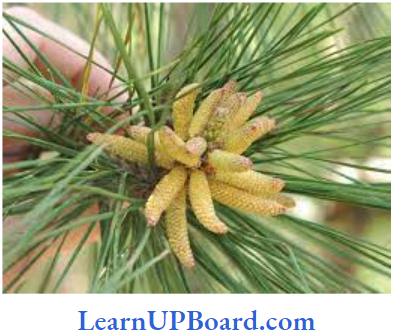
The number of needles is 1, 2, 3, 4, and 5 in a spur of P monophylla, P. sylvestris, P. roxburghi, P. quciddfolia, and P. wallichiana, respectively. It has a tap root system with long horizontal roots. Mycorrhiza occurs near the soil surface. Mycorrhizal roots lack root hairs and root caps.
- Vegetative reproduction is absent. Pinus is monoecious and develops clusters of shortly stalked male cones subterminally on the lower branches and female cones in the circle of 2-6 on the upper long branches.
- Each male cone has a short stalk, a central axis, and a number of spirally arranged microsporophylls. A microsporophyll bears two oblong, parallel microsporangia on its lower surface.
- In a microsporangium, the diploid microspore mother cells undergo meiosis and form haploid microspores or pollen grains.
At maturity, the pollen grains are released from the male cones and dispersed by air currents. Pollen grain has at this time two prothallial cells, a generative cell, and a tube cell. They are from yellow clouds in the pine forests. A pollen grain has two air sacs or wings to make it light. Male cones are homologous to dwarf branches.
- The female or seed cones develop in groups. 2-6 on the upper long branches of the tree. Each female cone has a long stalk and a central axis on which are a number of spirally arranged paired scales. The lower of the pair is called the bract scale while the upper scale is the ovuliferous scale or megasporophyll. The ovuliferous scale bears two ovules towards the basal region on the upper side.
- Each ovule has a Three-layered integument with a terminal wide, oblique pore or micropyle and a nucellus (megasporangium). In the middle of the nucellus, a megaspore mother cell differentiates. It forms four haploid megaspores by meiosis but only one survives.
The functional megaspore gives rise to the female gametophytes. The female gametophyte bears 1-8 archegonia. An archegonium has a short neck and a broad venter. The neck canal cell is absent. The Venter canal cell is ephemeral. The venter contains a large egg or oospore. Female cones are ho¬mologous to long branches.
- The female cones open in the year of theft formation for pollination. Pollination is anemophilous (by air) and direct. The pollen grains pass into the opened micropyle and rest on the top of the nucellus.
- The micropyle of each ovule contains a mucilage or pollination drop for catching the pollen. Here it germinates and forms a pollen tube but further growth is stopped due to the arrival of winter in the first year, in the spring of the next year, fertilization occurs.
- Fertilization occurs after 13 months from the time of pollination. The pollen tube grows and pierces an archegonium. One male gamete or male nucleus fuses with the oosphere to form a diploid zygote or oospore. The oospore forms an embryo while the ovule matures into a seed.
Part of the upper surface of the ovuliferous scale is peeled off along with the seed to form its wing. A female cone takes 26 months to reach maturity. It then opens to release winged seeds which are dispersed by air. After falling on suitable soil, each seed gives rise to a new plant.
NEET Biology Notes For Plant Kingdom Gymnosperms Points To Remember
The number of cotyledons in Finns ranges from 3 to 18.
- There are four tiers proembryo basal embryo tier, suspenser tier, rosette tier, and upper tier. The development of sporangium in Pinus is eusporangiate and fertilization is siphonogamous type.
- Resin is collected by injuring the Pinus.
- Resin is a semifluid secreted by special tubes. It solidifies on exposure to air. Therefore, it plugs the places of injury. It is an antiseptic and commercially distilled to obtain turpentine and resin. Resin is used in waterproofing, sealing joints, and preparation of writing paper. Turpentine is used as a solvent in paints, polishes, and wax.
- Seeds of P. gerardiana (chilgoza) are edible after roasting.
- Smallest gymnosperm = Zamia Largest gymnosperm = Sequoia dendron
- The three generations in a seed are:
- Testa, tegmen, and perispenn represent parental sporophyte;
- Endosperm represents female gametophyte;
- Plumule, radicle, suspensor, and cotyledons (embryo) represent future sporophytes.
- Polyembryony: It is the formation of more than one embryo inside a single seed. It was reported by Leu-wenhoek in oranges. Simple polyembryony is due to the fertilization of many eggs, for example, the Pinus ovule has 2-8 archegonia. Cleavage polyembryony is true polyembryony and very common. It is due to the splitting of embryo tissue. Adventive polyembryony is the formation of extra embryos directly from diploid cell (for example, rosette cells) other than embryonal cells.
Cycas
- It is a dioecious plant.
- Female cone absent.
- The stem is unbranched, cylindrical, i.e., caudex.
- Coralloid roots are present
- Cycas show fern ancestors in the presence of ramenta, circinate ptyxis, and multicilliated sperms.
- Vascular bundles are arranged like an inverted omega in the rachis.
- It has the largest ovule, largest male gamete, and largest egg in the plant kingdom.
- Fertilization occurs at three stages.
- Fertilization is siphonogamous and zooidogamous.
- Seed has two cotyledons.
NEET Biology Notes For Plant Kingdom Angiosperm (Flowering Plants)
These are the most advanced plants, characterized by the presence of flowers, covered ovules, and seeds. These form the largest group of the plant kingdom, containing about 300 families, 8000 genera, and about 300,000 species. These are the highest-evolved plants on this earth.
From the Cretaceous period, the angiosperms eclipsed all other vegetation, and now they are the most dominant plants. They are found almost everywhere in all possible habitats. Angiosperms include all varieties of plants such as hydrophytes, xerophytes, epiphytes, parasites, saprophytes, insectivorous, symbionts, mangroves, etc.
Characteristic Features Of Angiosperms
- The presence of flowers is the most striking feature of angiosperms. It contains the sex organs of the plant.
- Ovules are covered and are present inside the ovary.
- pollen grains are received by the stigma of the carpel, so maturation of pollen grain (male gametophyte) takes place on the stigma.
- Double fertilization (syngamy and triple fusion) is also characteristic only to angiosperms.
- Endosperm is formed after fertilization, and it is generally triploid.
- Vessels and companion cells are present in the xylem and phloem elements, respectively.
- Fertilized ovules ripen into seeds. The seeds are cov¬ered by fruits. A fruit is technically a ripened ovary7. Fruits not only protect the seeds but also help in their dispersal.
- The xylem contains vessels.
- Phloem possesses sieve tubes and companion cells.
- Spanish moss (Tillandsia) is an epiphytic angiosperm.
- A gametophyte can be haploid or diploid but always produces gametes.
- Monocots do not grow in girth though they grow in length and produce new leaves and flowers. Dicots have indefinite growth. New roots, shoots, leaves, bark, and wood are formed year after year.
- Petals are showy and are meant to attract animal pollinators, especially insects.
- In most of the plants, pollination is effected by animal insects, worms, birds, bats, and even human beings. Insectaccomplished pollination is termed as entomophily.
- Angiosperms are divided into two sub-groups, i.e., dicots and monocots.
Dicots: They are angiosperms or flowering plants that are characterized by the presence of two cotyledons in the seed, and generally reticulate venation in leaves (with a few exceptions Calophyllum and Etyngium). Concentric tissues in the stem with open vascular bundles are arranged in a ring: penta or tetramerous flowers.
Monocots: They are angiosperms or flowering plants which are characterized by the presence of a single cotyledon in the seed, generally parallel venation in the leaves (except Smilax, Colocasia, and relatives), scattered closed vascular bundles in the stem, and trimerous flowers, for example, banana, cereals, palms, grasses, bamboo, lilies, orchids, etc.
Differences Between Various Plant Groups
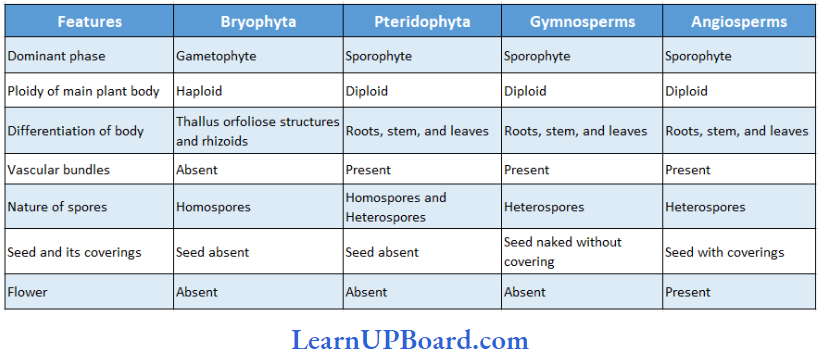
NEET Biology Notes For Plant Kingdom Angiosperm (Flowering Plants) Points To Remember
Bessey, Oswald Tippo, Cronquist, and Thom also proposed a phylogenetic system of classification.
- Thallophyta term was given by Endicher.
- M.O.P. Iyenger is known as the father of Indian psychology.
- Also known as vascular cryptogams, vascular amphibians, snakes of the plant kingdom, are seedless tracheophytes.
- Hironymus divided the genus Selaginella in two subgenera, viz., Homeophyllum and Heterophyllum.
- The term gymnosperm was used by Theophrastus in his book “Enquiry into Plants.”
- C. revolution is called as sago palm. Sago is obtained from C. revolute.
- Drug ephedrine is obtained from Ephedra which is used in curing respiratory ailments including asthma.
- Ginkgo biloba is known as the “maidenhair tree.”
NEET Biology Notes For Plant Kingdom Different Life Cycles And Alternation Of Generation
The life cycle of a plant is called the alternation of generations. In plant life, there are two phases, one diploid sporophyte and one haploid gametophyte, which give rise to each other. In this process syngamy and meiosis are instrumental.
Sporophyte produces spore after meiosis which develops into gametophyte (gamete-producing plant). The gametes undergo fusion/syngamy to form a diploid zygote. The fate of the zygote depends upon the kind of life cycle.
Types Of Life Cycles or Patterns Of Alternation Of Generations: There are three chief kinds of life cycle. They fundamentally differ in the duration of the haploid and diploid phases. They are as follows.
Haplontic: It is characterized by the dominance of haplophasc. The plant body is gametophyte and independent. The sporophyte is dependent on gametophyte and is not a free-living body. The major part of life is enjoyed by gametophytes, for example, the majority of green algae viz, Chlamydomonas, Ulothrix, Spirogyra, etc.

Diplo-haplontic Or Haplo-diplontic: it is characterized by the existence of sporophyte as well as gametophyte. Both of them are photosynthetic and free-living and the two phases, diplophase and haplophse, are nearly equal.
If sporophytes and gametophytes are morphologically different, then the life cycle is termed as diplo-haplontic; heteromorphic, for example, All pteridophytes; all bryophytes; some brown algae, viz., Laminaria and other kelps.
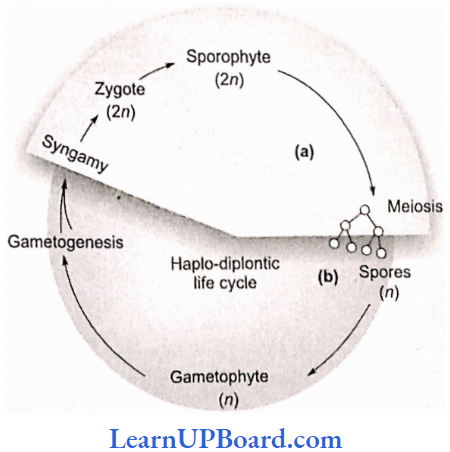
If the two phases are morphologically identical, then the life cycle is termed as diplo-haplontic isomorphic, for example, Green algae, viz., Ulva and claclophora\brown algae, viz., Eclocarpns.
Diplontic: It is characterized by the dominance of diplopia. The plant body is sporophyte which is independent and free living. The gametophytes are extremely reduced and are dependent physically as well as nutritionally on (lie sporophyte. the major purl of life is enjoyed by the sporophyte, for example, all gymnosperms and angiosperms; diatoms; some brown algae, viz., Fuats and Sargussum.
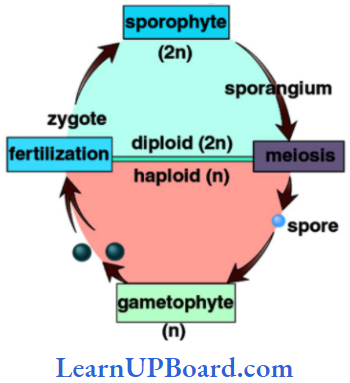
NEET Biology Notes For Plant Kingdom Assertion Reasoning Questions And Answers
In the following questions, an Assertion (A) is followed by a corresponding Reason (R). Mark the correct answer.
- If both Assertion and Reason are true and the Reason is the correct explanation of the Assertion.
- If both Assertion and Reason are true, but the Reason is not the correct explanation of the Assertion.
- If Assertion is true, but Reason is false.
- If both Assertion and Reason are false.
Question 1. Assertion: Thallophytes are non-vascular, non-archego- niate. and non-cormophytic plants.
Reason: Thallophytes lack vascular bundles, archegonia, and differentiated plant body.
Answer: 1. If both Assertion and Reason are true and the Reason is the correct explanation of the Assertion.
Question 2. Assertion: Funaria archegonium has a maximum concentration of sucrose at the tip of the neck.
Reason: Male gametes show chemotropic movement.
Answer: 3. If Assertion is true, but Reason is false.
Question 3. Assertion: Pyrenoids may or may not be surrounded by a sheath of starch plates in algae.
Reason: In higher plants, these are replaced by amyloplasts.
Answer: 2. If both Assertion and Reason are true, but the Reason is not the correct explanation of the Assertion.
Question 4. Assertion: Seeds are formed by some species of spike moss.
Reason: All conditions for seed habit are fulfilled by these species of spike moss.
Answer: 4. If both Assertion and Reason are false.
Question 5. Assertion: The resin duct in coniferales is schizogenous in origin.
Reason: The resin duct helps to retain water as well as seals the injured areas of plants.
Answer: 2. If both Assertion and Reason are true, but the Reason is not the correct explanation of the Assertion.
Question 6. Assertion: Chlorella, a green alga, is commonly known as space alga.
Reason: It is used by exobiologists for oxygen and disposal of nitrogen in prolonged space flight.
Answer: 3. If Assertion is true, but Reason is false.
Question 7. Assertion: Bryophytes are not the amphibians of Plant Kingdom.
Reason: An external layer of sucrose instead of water is necessary for the movement of antherozoids.
Answer: 4. If both Assertion and Reason are false.
Question 8. Assertion: Polyploidy is very common in the members of Filicophyta.
Reason: It is due to the development of gametophytes
Answer: 1. If both Assertion and Reason are true and the Reason is the correct explanation of the Assertion.
Question 9. Assertion: The micropyle of Pinus ovule contains pollination.
Reason: The ovule of Pinus is unitegmic and orthotrodirectly from sporophyte without meiospore formation.
Answer: 2. If both Assertion and Reason are true, but the Reason is not the correct explanation of the Assertion.
Question 10. Assertion: Calophyllum leaf has parallel venation and ligation drop for catching the pollen.
Reason: It is the plant of the dicot group of angiosperms.
Answer: 2. If both Assertion and Reason are true, but the Reason is not the correct explanation of the Assertion.
